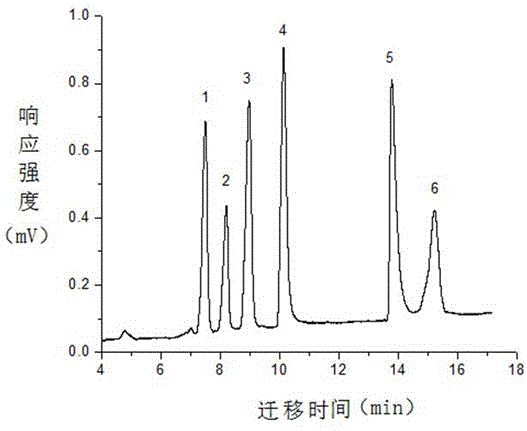Method for continuously separating synthetic pigments in multiple modes with pCEC (pressurized capillary electrochromatography)
A technology of capillary electrochromatography and capillary separation, which is applied in the field of analytical chemistry, can solve the problems of few studies on multi-mode continuous separation and no reports on multi-mode continuous separation, and achieve the effect of improving the separation effect
- Summary
- Abstract
- Description
- Claims
- Application Information
AI Technical Summary
Problems solved by technology
Method used
Image
Examples
Embodiment 1
[0025] A pressurized capillary electrochromatographic multi-mode continuous separation method for synthetic pigments is to use electrophoresis-electrochromatography multi-mode continuous separation technology to continuously form a multi-mode separation with a quartz capillary with a bare inner wall and a capillary chromatographic column with a chromatographic filler. Capillary column analysis, the specific method is as follows:
[0026] 1) Select a multi-mode capillary separation column with an effective column length of 15cm and an inner diameter of 100μm, of which the length of the quartz capillary part is 7.0cm, and the length of the capillary column part with packing is 8.0cm, and the packing is octadecyl bonded Silica gel particles, the particle size is 3μm;
[0027] 2) Use acetonitrile:tetrabutylammonium bisulfate (3.0mmol / L, pH4.0) = 30:70 (v / v) mixed solution as mobile phase, degassing by ultrasonic;
[0028] 3) In the way of isocratic elution, adjust the pressure of...
PUM
| Property | Measurement | Unit |
|---|---|---|
| length | aaaaa | aaaaa |
| length | aaaaa | aaaaa |
| length | aaaaa | aaaaa |
Abstract
Description
Claims
Application Information
 Login to View More
Login to View More - R&D
- Intellectual Property
- Life Sciences
- Materials
- Tech Scout
- Unparalleled Data Quality
- Higher Quality Content
- 60% Fewer Hallucinations
Browse by: Latest US Patents, China's latest patents, Technical Efficacy Thesaurus, Application Domain, Technology Topic, Popular Technical Reports.
© 2025 PatSnap. All rights reserved.Legal|Privacy policy|Modern Slavery Act Transparency Statement|Sitemap|About US| Contact US: help@patsnap.com

